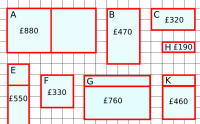Some thoughts on teaching about area
One of the most common problems that arises when secondary school students work on problems about area is the confusion between area and perimeter. Looking at a common textbook treatment of area and permiter suggests why this confusion might arise: many textbooks introduce perimeter and area separately, but on consecutive pages of the book, using exactly the same diagrams and examples, often looking at areas of rectangles. A child takes away from this a formula for area (length multiplied by width) and a formula for perimeter ($2l + 2w$) having worked mainly with rectangles.
Image

Image

Another common misconception among students with a shaky grasp of area and perimeter is the notion that the two increase together, that is, the greater the area the greater the perimeter and vice versa. Changing Areas, Changing Perimeters directly challenges that notion by provoking students to think about the two quantities together and to vary one while keeping the other the same.
Area is an important concept for older students too. When learning about calculus, the idea of integration as area becomes very useful for applications. Many students have a superficial understanding of differentiation based on applying a rule ($x^n$ differentiates to give $nx^{n-1}$) and then learn integration as the inverse of differentiation. In the same way that learning about area and perimeter separately, as rules to be memorised, leads to students confusing the two concepts, many markers of A level papers will have seen students integrating rather than differentiating, or vice versa, because the students are following a rule rather than showing their understanding of a concept.
Image

Research shows that conceptual understanding leads to students retaining knowledge much better than rote learning of formulae. We hope that working on some of the tasks identified above will help students to develop the important concepts that will lead to better understanding as well as examination success!
